- Products
- Solutions
- Service
- Company
MiniTec SmartAssist is used in a wide variety of areas. In addition to workshops for the disabled, there are also many useful fields of application in industry, such as manual assembly or order picking. Knife manufacturer Martor uses the assistance system to train its employees. A field report.
Martor is a leading international partner for safe cutting solutions. The Solingen-based family business has been combining quality with innovation for over 80 years to produce premium cutting tools for industrial and professional purposes. Today, the Martor brand is represented by partners and dealers in more than 70 countries worldwide. Martor's safety knives are as diverse as its customers' requirements, with around 300 different types on offer. They are all assembled at the company's headquarters in Solingen - by hand. Some knives have a very simple design and consist of just three parts, others are much more complex.
Manual assembly according to instructions
To ensure that assembly runs smoothly, Martor invests a lot of time and money in training its employees. Previously, this was done by giving the employee assembly instructions and having a team leader show them the individual steps. The employee then tried to carry out the assembly himself. His boss constantly looked over his shoulder and gave him tips. This approach proved to be not particularly efficient and no longer up to date. The employee often became nervous and the supervisor was unable to carry out his actual duties during the training phases.
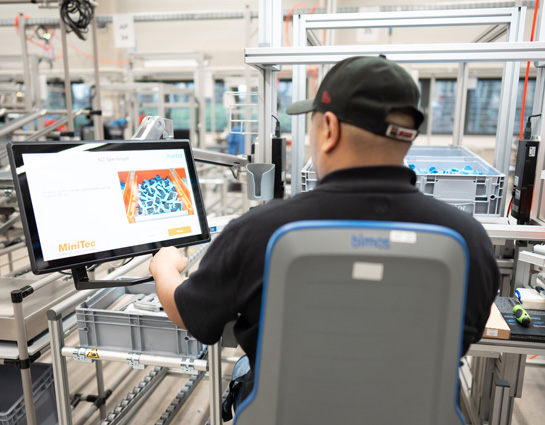
A touch screen guides the worker step by step through the assembly process.
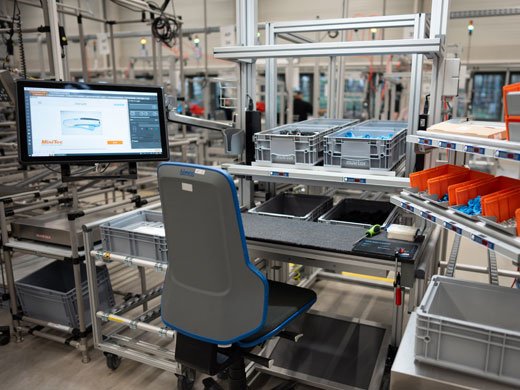
At Martor, the ergonomic assembly workstation and interactive assistance system form a functioning unit.
MiniTec SmartAssist for employee qualification
Martor pricked up its ears when MiniTec offered to act as a pilot customer for the new MiniTec SmartAssist assistance system. They quickly agreed to the proposal and had a corresponding table designed. The main purpose of the table is to provide interactive training and
training of employees with regard to knife assembly. However, it is not located in a separate training room, but together with the "normal" workstations in the middle of the assembly area. In order to familiarize itself with the assistance system, Martor initially focused on a selected product as a "test object", the Secupro 625. This is a plier handle knife with extensive features, such as a lever for releasing the blade, fully automatic blade retraction and convenient blade changing.
The high-end tool consists of a total of 16 components, which are joined together in various, sometimes complicated assembly steps. In future, however, other knives are to be trained on the assistance system, says Kevin Kowalsky, Shift Manager Production at Martor and at the same time The worker is guided step by step through the assembly process via touch screen. Ergonomic assembly workstation and interactive assistance system form a functioning unit at Martor. The supervisor for the MiniTec SmartAssist project: "We want to use it to assemble the MegaSafe, for example. Or our latest model, the 610 XDR. And it is to be extended to other models - everything that has a lot of parts and is somewhat more complex in terms of the work processes."
Use of different modules
A touchscreen, a push-button and pick-to-light light strips are used as assistance modules, some with intervention sensors. The individual work steps are displayed to the worker on the monitor with corresponding aids (texts, arrows and images). They can confirm completed tasks directly on the screen or via the buzzer and move on to the next step.
The various components of the respective knife are located in boxes within easy reach of the worker. The Pick To Light light strips indicate which compartment the operator needs to reach into next. The system uses the intervention monitoring function to detect whether he has done so and acknowledges this internally so that the next assembly step is displayed. For certain components, the sensor is not activated; in this case, the employee presses the buzzer to signal that the component has been removed and to move on to the next step. Martor has 22 of these pick-to-light modules in use. Some of the components are already assembled into modules in advance.
For this reason, 16 components remain for the MiniTec SmartAssist table and thus work steps for assembly there. The integration of videos into the on-screen instructions is also planned for the future, which will be possible from the new version 2.9. Kowalsky explains: "Images are often not sufficient, especially when the work steps become more complex. For example, hooking spring eyelets. Or how to avoid overstretching the springs. We want to support all of this with videos in future."
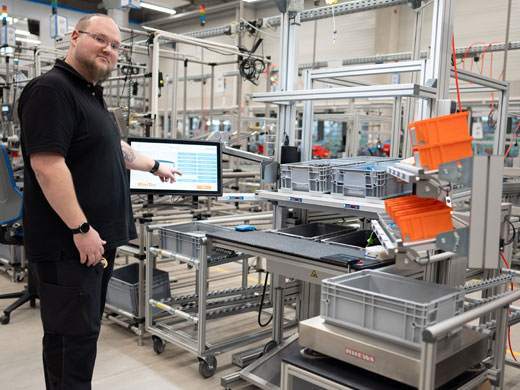
Kevin Kowalsky is breaking new ground in the field of employee qualification with MiniTec SmartAssist.
Autonomous learning with the best results
The training process is now completely different with MiniTec SmartAssist. Instead of being constantly monitored by their supervisor as before, employees are now completely autonomous. They sit alone at the training table, without an accompanying person, and simply get started. The system guides him through the assembly process in a structured manner, showing him every single step. In this way, he learns how to assemble the knife on his own, without stress, and his team leader has more time to devote to other tasks. "The result is a classic win-win situation. And last but not least, it also saves Martor an enormous amount of time and money," emphasizes Kowalsky. The system is also very well received by the employees, he says: "We put a lady with no previous experience on the complex 625 knife and said, just give it a try - and it worked perfectly straight away!"
His colleague had been able to do the work very well and quickly and was absolutely delighted with it. The fact that she learned the assembly so quickly was also practical for the company. This meant that they could be at the right workstation less than an hour later. And it worked as if she had never done anything else. "The user-friendliness is very good, even for people who don't work in production every day. Because we occasionally have new employees in other areas, such as sales. And we've also put them on it, and they've also got on really well with it. The feedback was very positive."
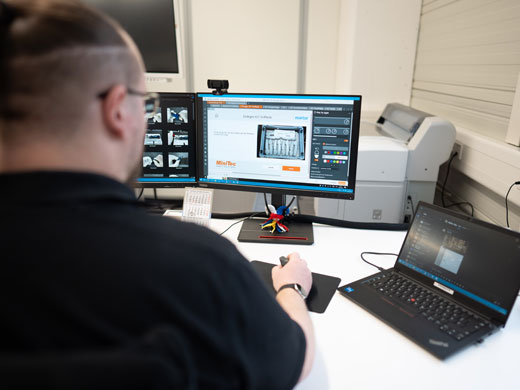
Kevin Kowalsky is responsible for creating the instructions in the editor.
Simply create instructions in the editor MiniTec SmartAssist enables companies to create their own instructions using the editor. At Martor, Kevin Kowalsky takes care of this task; in future, he will be supported by two colleagues. According to Kowalsky, his experience with the tool so far has been consistently good: "I create the recipes both directly at my desk,
as well as via Teamviewer access. There was a short familiarization phase at the beginning, during which I learned the meaning and use of the various operating elements. But once you're in, it's quite intuitive and self-explanatory."
This applies to all areas - whether it's inserting and manipulating images or configuring the Pick To Light. "We can use two positions for each of the stations. The colors can also be changed. You can also set whether it should light up continuously or flash, there is a great deal of variety." Kowalsky is also very positive about the editor in general: "I definitely see the fact that we can create the instructions ourselves as an advantage. We are self-sufficient and much more flexible. Even if there is another change to a component of a knife, for example, we can add it quickly and easily."
Assisted training as a basis in future
Based on the positive experience, Martor wants to use the system as the linchpin for its qualification matrix in future. In this matrix, each employee is assessed as to whether they can assemble a product, whether they can pack it and whether they can work on a machine. In other words, their know-how status. The idea here is to equip two or three tables with MiniTec SmartAssist and run the qualification matrix over them. If an employee has then learned how to assemble a particular blade with the assistance system, they will receive a corresponding entry.
Many ideas for further expansion
In addition to use in the training environment, Martor can also imagine using the assistance system for quality assurance, says Kevin Kowalsky: "For example, the 625 knives have to be placed in the KLT with the screw facing upwards after completion so that the employee can check whether it is in place. It would be an advantage if this check were carried out using a camera. Such a quality check would also be useful for the final function test. This is carried out by activating the blade three times and pulling it off on a cutting mat. The blade is extended, positioned and checked to see whether the blade retraction works.
It would be great if a sensor could be used to check whether the employee has done this or not. In addition, the assistance system could then be used to document when a blade fails, i.e. is NOK - together with the instruction to place it in an appropriate container. "The project participants at Martor already have numerous other ideas and impulses as to how the assistance system can be expanded to include additional functions and features in the future. And they are finding that MiniTec Smart Solutions and the developers are open to these ideas, as this is another effect that MiniTec wants to see with pilot customers.
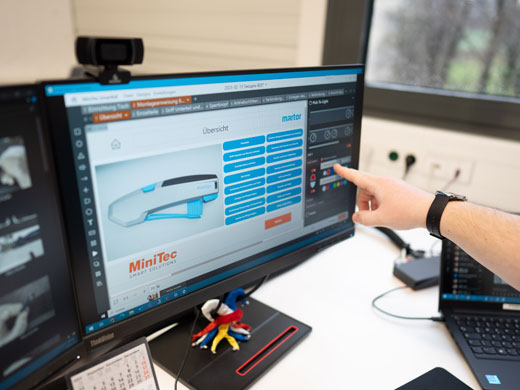
What you see is what you get: The view in the editor is already very similar to the later display in the player.
Conclusion: Easier training, higher quality
Based on the experience gained, Kowalsky comes to an extremely positive conclusion: "MiniTec SmartAssist is a very useful system for industrial companies. It is an enrichment and a relief for Martor, and it ensures that fewer errors occur. It also enhances our image. Major customers who have visited us have often expressed their appreciation for the fact that we use such modern tools to train and qualify our employees - and thus also to ensure quality."
Do you need a suitable solution or an approach for your project? Then please contact us!